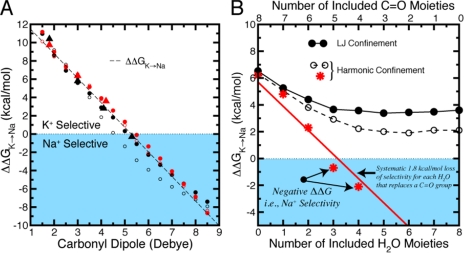Figure 3.
Dependence of K+/Na+ selectivity on ligand composition in eight-ligand binding site models where ligand distances are generically confined to be within a 3.5-Å radius of the central ion. (A) The conventional field strength trend observed by Eisenman is illustrated by the dependence of selectivity, ΔΔG, on the dipole moment of linear ligands. Results were taken from binding site models described previously (red triangles, Noskov et al., 2004; black triangles, Thomas et al., 2007; circles were calculated with standard [black] or modified [red] CHARMM parameters, Bostick et al., 2009). Filled circles show results from a half-harmonic boundary restraint, and open circles show the corresponding Lennard-Jones restraint. The conventional field strength trend (dashed line) is independent of these different restraints. (B) Dependence of K+/Na+ selectivity, ΔΔG, on incremental replacement of carbonyl-like dipolar groups with water molecules. In contrast to the trend in A, recent work predicted a systematic loss of selectivity for each water molecule that replaces a carbonyl group (∼1.8 kcal/mol per water using the CHARMM force field) (Noskov and Roux, 2006, 2007). The red line illustrates this trend toward Na+ selectivity, which supports the revised field strength model. Data from subsequent calculations (Bostick et al., 2009), using the same force field and either a Lennard-Jones (LJ, black solid lines/circles) or a half-harmonic (black dashed lines and open circles) confining potential, do not eliminate the K+ selectivity.

